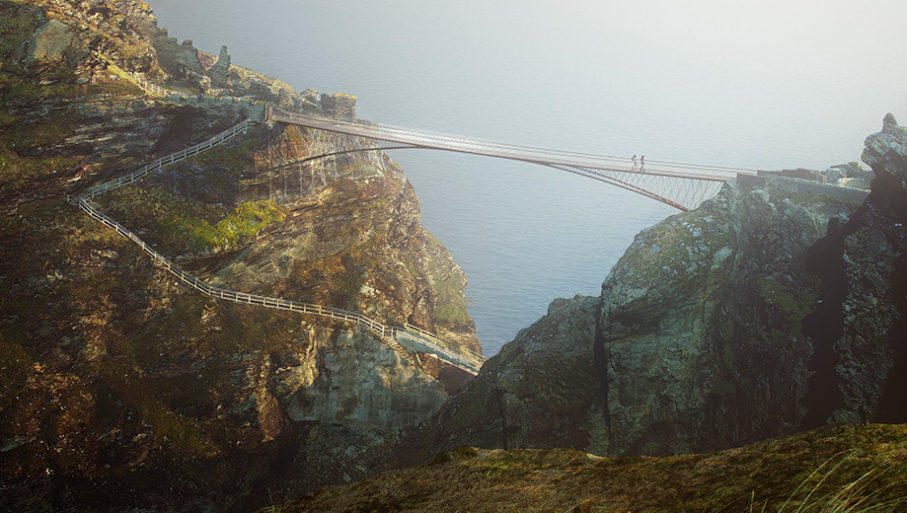
English Heritage announced today, March 23 2016, that the team led by Ney & Partners – with emerging UK-based architectural practice William Matthews Associates – has won the Tintagel Castle: Bridge Design Competition.
The expert jury reached a majority decision on the winning team, which beat 136 others in the course of the two-stage international design competition to secure the architectural and engineering commission for the circa £4m English Heritage project in Cornwall.
The winning concept design is distinctive for its elegant, delicate profile and structural ingenuity. The proposal is based on two cantilevers and envisages a poetic gap between the two; it will recreate the land-link that once existed between the mainland and headland and reference the current void, caused by erosion.
As the team explained in its winning presentation, ‘The narrow gap between the cantilevers represents the transition between the mainland and the island, here and there, the present and the past, the known and the unknown, reality and legend; all the things that make Tintagel so special and fascinating.’
The team’s inspiration for their cantilevered solution came from their study of Celtic history and the original drawbridge arrangement of Tintagel Castle. They propose using local slate for the bridge’s decking and contrasting weathered and non-weathered steel to create finishes which allow sunlight to play on the structure but also give it an ephemeral quality, allowing the bridge to harmonise with the coastal landscape.
The concept design was popular with the public following an exhibition held in Tintagel village in December 2015 (view shortlist).
The new bridge, twenty-eight metres higher than the current crossing, is expected to transform the visitor experience of Tintagel Castle, improving understanding of, and access to, this historic site, one of the most dramatic and loved in English Heritage’s care.
Kate Mavor, chief executive of English Heritage, said,
‘The winning team’s concept is daring and very exciting. It is not the final design but instead a brilliant indication of the team’s talent and imagination. We will now work with them on a design that will both complement the spectacular landscape and unlock for the visitor the history of the site.
‘In our new role as a charity, we are looking for new, imaginative ways to interpret the sites in our care and inspire our visitors – this bridge forms part of that approach.’
Graham Morrison, chair of the jury, said,
‘This is a strong and confident concept design with a thoughtful geometry that meets the demanding, multi-faceted Brief. The team presented with admirable clarity – both at interview and in the written materials. In the end, the jury was persuaded as much by the technical assurance of Ney’s proposal, and its buildability, as its aesthetics and sensitivity to the exceptional setting.’
Malcolm Reading, architect and competition organiser, said,
‘This competition attracted interest from nearly thirty countries and generated an impressive turn-out of top-tier firms. We would like to thank the shortlisted teams for their dedication and commitment and the jury for its insights and industry. The jury had to pick one winner, but each of the six finalists performed at the highest level, and the range of proposals was inspiring.’
Laurent Ney, managing director of Ney and Partners, said,
‘We are absolutely delighted to win the competition. We believe the experience of visiting Tintagel Castle is all about discovery and revelation, so it is important to us that our bridge lets the majesty of the site do the talking, that it is not too intrusive. Just as a good art museum recognises that the art is greater than the building so the new bridge needs to make the visitor’s reading of Tintagel – its history and cultural power – as strong as possible.’
William Matthews, founder of William Matthews Associates, said,
‘Tintagel Castle attracts visitors for many reasons: the dramatic landscapes and geological formations, the Dark Ages remains, the ruined 12th century castle and the legends of King Arthur and Tristan and Isolde. Together, they breathe an undeniable and powerful sense of life into the place – to be invited to contribute to that is a rare privilege and honour.’
Announced in September 2015, the shortlisted teams (below) were chosen from 137 Expressions of Interest. The shortlist was:
- Dietmar Feichtinger Architectes with Terrell (France)
- Marks Barfield Architects with Flint and Neill (UK)
- Ney & Partners with William Matthews Associates (Belgium)
- Niall McLaughlin Architects with Price and Myers (UK)
- RFR and Jean-François Blassel Architecte, with EngineersHRW, and WSP (France)
- WilkinsonEyre with Atelier One (UK)
Ney & Partners is a renowned bridge designer with offices in Belgium, Luxembourg and Japan. All the firm’s projects ‘are driven by a strong relationship to context and by the poetic value of design, engineering and architecture’. While the firm has produced nearly 100 bridge designs over the last 18 years, recent projects include two footbridges to encircle the UNESCO World Heritage site at Smedenpoort Gate in Bruges, Albi Footbridge in France and the Dejima Footbridge in Japan (a future UNESCO World Heritage site) and the roof of the Dutch Maritime Museum in Amsterdam.
William Matthews Associates is an emerging architectural practice based in London. Prior to establishing the firm in 2013 William was an associate at Renzo Piano Building Workshop where he was lead architect of the Shard.
Attracting over 200,000 visitors annually, Tintagel Castle is one of the most spectacular historic sites within English Heritage’s care. This scheduled ancient monument is inextricably linked to the legend of King Arthur and has been prized throughout history for its elemental qualities and spirit of place within this area of outstanding natural beauty.
Development of the design will now commence in advance of consent applications later in the year. The project is expected to be completed by 2019.

